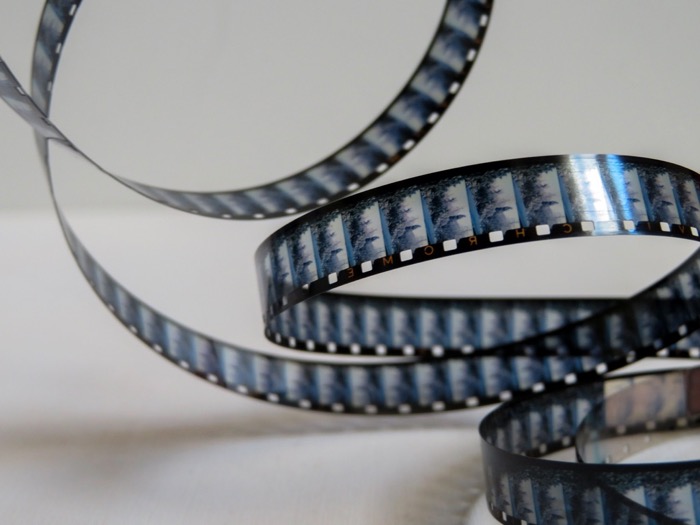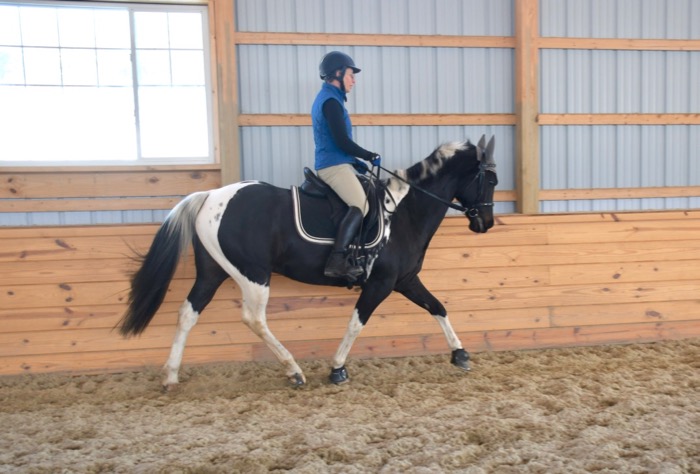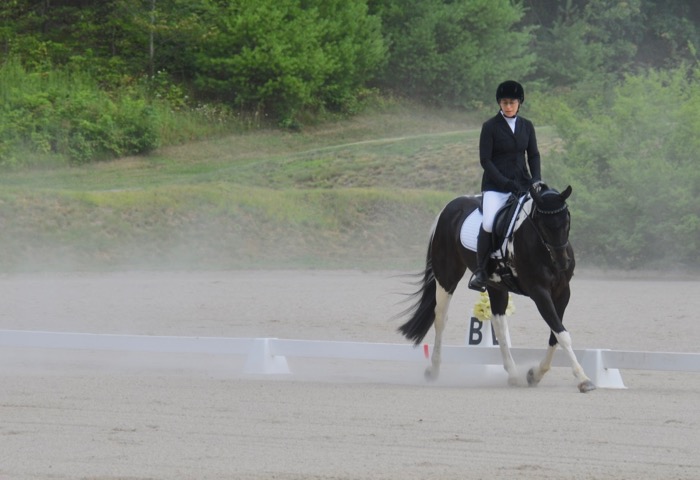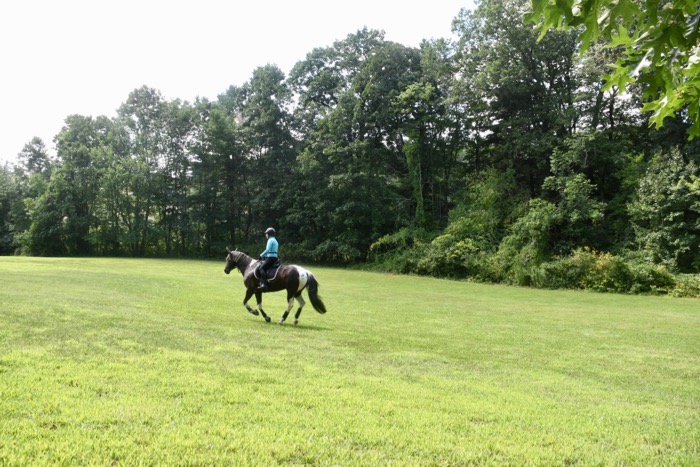Last weekend I audited a dressage clinic. Most of the participants were on mounts that I call the Lamborghinis of the horse world – huge warmbloods with power and flash.

I happened to sit next to a woman who was up here from Texas, visiting a friend who rides dressage. A horse danced across the ring in a half-pass. Fancy stuff. She learned over to me and said, That’s pretty. I grew up riding, but we just got on and went. When we wanted to go, we kicked, when we needed to stop, we pulled on the reins. It was fun. It is. I’m jealous of the kids who got to gallop around fields with their ponies. I wish I’d had that childhood. I didn’t get to ride without supervision until I got my own horse when I went to college. Now, I can ride Tonka wherever I want. But I’m not as carefree as that woman who got to ride pell-mell in Texas, and that’s not a bad thing. In fact, riding acutely tuned into my horse is one of the great joys of my life.
The horse feels every single little thing that we do on their back. That can be one of the most rewarding riding experiences, but also its greatest challenge. Be thoughtful about your horse’s ability to read what you’re doing, be consistent, reward for the response you want, and your horse will sync how they go to match slight shifts in your body position. But if you ride with a heavy hand and a jarring seat, they’ll brace against you. If you make sudden demands, unconnected to what you’ve just done in the saddle, they’ll learn to ignore you, until you end up having to do the equivalent of yelling to get a response.
Not all of us are willowy, athletic, and perfectly poised in the saddle. That’s okay. We can still communicate in a subtle and nuanced way. Which should be the goal – because that creates an understanding between you and your horse that makes riding flow, and it eases the frustration (and possible discomfort) that the horse experiences when you sit up there telling them what to do.
Regardless of riding skill, here is how you can achieve a clear dialog with your horse: slow down the film and ride frame-by-frame.

Photo by Denise Jans on Unsplash
When you view a movie, once second of action is actually made up by 24 individual frames. A lot is going on to make that tiny bit of action. That’s true in riding, too.
Take a look at this transition from walk to trot. Looks easy, doesn’t it?
The first (and possibly most important) step was that when Kim told me to pick up the trot, I didn’t just do it. Instead, I prepared and rode frame -by-frame. It took only five seconds, but it made all the difference. We’re so conditioned to jump to, and do what our instructors say as soon as they say it. I see this all the time when I’m teaching. If I ask my student to trot, off they go! They cue the horse without thought, and what results is either rushed or balky, and although the horse eventually goes faster, both horse and rider go tenser, too. Which is why instead I say, we’re going to pick up the trot at (fill in the spot in the ring) and then I break it down to this:
- take a breath
- feel both sitting bones evenly in the saddle
- waist down, drop your weight down through your legs to the flats of your feet
- waist up, sit tall through your core
- elbows at hips
- thumbs up
- look at your destination
- tip your pelvis just a tad to cue the upward transition
- close legs with a tiny squeeze to be clear that you’re going into the next gait
- soften with the ring fingers to allow the horse to go forward
Depending on the rider and horse, I might add or subtract frames and details.
It doesn’t always work out how you want. Sometimes it’s not pretty. (Here Tonka is bracing with the underside of his neck and clamping his mouth.)

But if you’re riding frame-by-frame, you don’t have to scuttle everything. Instead you can fix one small piece, and get back to harmony without a lot of drama.

It especially helps to use this film analogy when you’re in a high-pressure situation like a competition. In this test, I had to begin the 10-meter half-circle at B, which means that a good five strides out, I began talking myself through each frame. I tend to lean in, so one of my frames is weight on the sole of my outside foot.

Remember that like in a film, the frames are there, and are essential, but the viewer doesn’t see them – even when you’re just having fun cantering around a field.

Is there a piece of your riding that you think could be improved by riding frame-by-frame? Leave a comment. Let’s discuss!


Frame-by-frame is a good analogy. A week ago I audited a clinic with Lisa Wilcox (lots of horse Lamborghinis) that has resulted in mostly superlative rides ever since. Yesterday I audited a clinic with Anna Blake that needs to simmer or ferment awhile. I do think we can OVERthink our riding to the point that we’re not listening to our partner, but it requires a great deal of focus to communicate clearly and allow our horses to use themselves in the best way possible.
Very good point about over-thinking! I think that happens when you have muddled-thinking 🙂 When things don’t go well, you obsess. But if you have simplicity and clarity in the small things, it becomes easy. Or easier… if you expect perfection, then you over think!
By the way, as much as I enjoy watching those Lambo horses, I’ve no desire to own one. I’m very happy to have my little, sane horse who I can ride with confidence 🙂
As a beginner, I would say any corner is very tough for me to set up. Shoulders turned / leg on / half halt before the turn is about all I have brainspace for . I also tend to try to rush or cut out strides, and there am working on being patient.
Hi John – I think this advice is especially important for beginners, who often believe that they have to do everything at once. Breaking down the aids into much smaller pieces helps to identify the bits so that you can put them together correctly. Sometimes, what feels like a mess can be improved with a very small change, like a lifting of a hand by an inch.
Corners are a challenge at any level! If it’s too difficult to stay in balance making a good turn, try riding the short side of the ring into a fluid circle instead.
Then, work on the half-halt on it’s own. For example, can you half-halt on the straight line? A half-halt has a purpose – to bring the horse back onto the aids, in better balance. It’s hard for a beginner to do, let alone feel! I’d start on the straight away. Can you do a regular walk and then a slower walk? Then back to regular walk? What aids do you use? Can you get your horse to do that change of tempo with just your seat? Or with seat and a slight closing of the hands? Once you can do that, can you do the slower walk for only 3 strides? For 2? Focus on the details… do short training sessions, and then go take a walk in the woods and don’t worry. Enjoy yourselves! 🙂
Thank you. Great analogy of how to think about things in smallest parts.
I’m glad it was helpful.